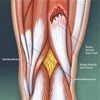An acute hamstring injury involves tearing of the muscle or tendon fibres from a singular point of exertion. Most commonly hamstring injuries result from either a running or kicking mechanism, essentially movements that involve acceleration and deceleration. Common sports that involve hamstring injuries are AFL footy, athletics, netball, basketball and hockey as they require regular bursts of sprinting.
Injuries to the hamstrings most commonly occur at what is called the musculotendinous junction. This is the point where the muscle and tendon fibres blend and as a result is the weakest point of any muscle. A tear occurs where the force produced within the muscle exceeds its capacity and results in muscle fiber failure. Acute hamstring tears can also occur within the muscle belly and the tendon, generally tears involving the muscle belly heal faster than tendon tears because of the type of tissue and large vascular supply. As a result, recovery time can vary largely and is also impacted by the severity of the tear.
The highest risk factor for a hamstring tear is a previous hamstring tear along with the severity of the previous tear.
Treatment of hamstring tears involves rest and avoidance of stretching within the inflammatory phase. The hamstrings should then be progressively loaded with strengthening exercises which your physiotherapist will guide you through. These exercises progress from slow sustained movements through to fast sports specific drills. This allows development of tensile strength within the the muscle fibres being repaired. Once adequate strength is gained a gradual running programme can be commenced with with a gradual return to sport.

